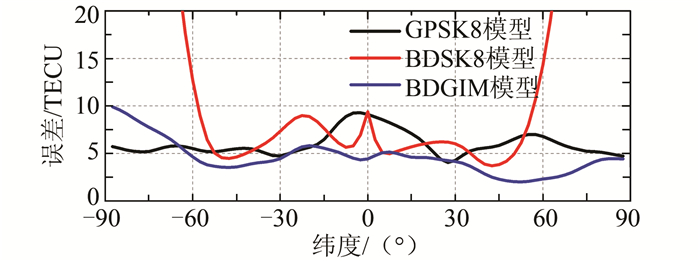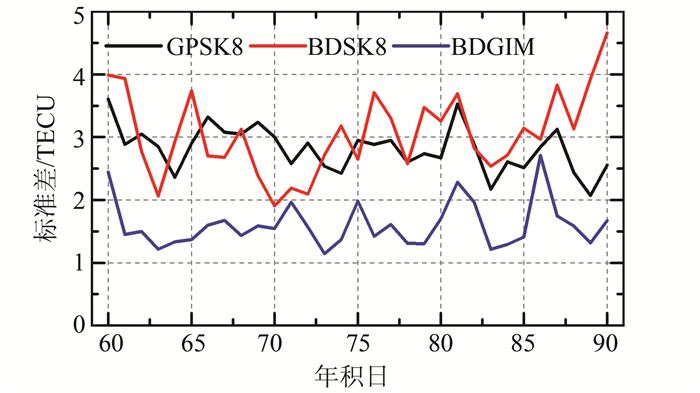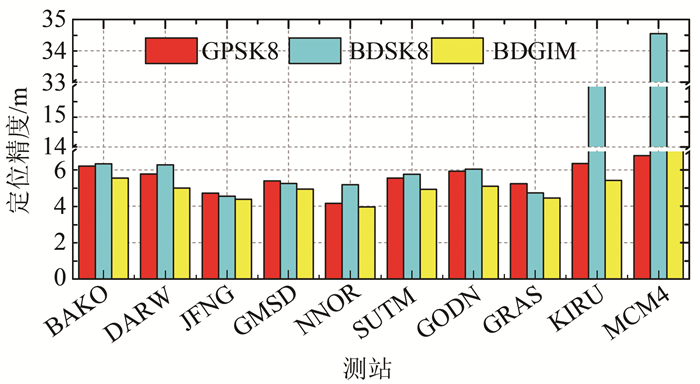Preliminary Performance Evaluation of BeiDou Global Ionospheric Delay Correction Model
-
摘要: 北斗三号系统于2017年正式启动建设,将采用新的北斗全球电离层延迟修正模型(BeiDou global ionospheric delay correction model,BDGIM)。使用高精度格网电离层数据和双频实测电离层延迟数据作为参考,对北斗试验卫星系统播发的BDGIM模型精度进行了相应分析和评估,并与北斗Klobuchar和GPS Klobuchar模型精度进行了比较。研究结果表明,在中国区域,BDGIM模型和北斗Klobuchar模型精度相当,优于GPS Klobuchar模型;在全球范围内,BDGIM模型精度优于北斗Klobuchar和GPS Klobuchar模型。采用不同电离层模型进行伪距单频单点定位,并对定位结果进行对比分析,结果显示,使用BDGIM模型比北斗Klobuchar模型的定位精度有13%的提高,比GPS Klobuchar模型有7%~10%的提高。
-
关键词:
- 北斗三号 /
- BDGIM /
- 北斗Klobuchar /
- GPS Klobuchar /
- 单频伪距单点定位
Abstract: The BeiDou global navigation system was officially launched in 2017 and will adopt a new BeiDou global ionospheric delay correction model(BDGIM). Using high-precision grid ionospheric data released by CODE and the Slant ionospheric delay derived from dual-frequency observations as a reference, the accuracy of the BDGIM model is analyzed and evaluated, and compared with the BeiDou Klobuchar and GPS Klobuchar models. The results show that in the region of China, the BDGIM model and the BeiDou Klobuchar model are comparable in accuracy and superior to the GPS Klobuchar model. On a global scale, the accuracy of the BDGIM model is better than that of the BeiDou Klobuchar and the GPS Klobuchar models. Different ionospheric models are implemented for single point positioning. The results show that the BDGIM model has a 13% improvement over the positioning accuracy of the BeiDou Klobuchar model, and a 7%-10% improvement over the GPS Klobuchar model.-
Keywords:
- BeiDou-3 /
- BDGIM /
- BeiDou Klobuchar /
- GPS Klobuchar /
- single point positioning
-
在导航定位应用中,电离层误差是信号传播过程的主要误差之一。卫星定位系统通过导航电文向用户提供广播电离层参数进行修正,从而提高定位精度和服务性能[1]。美国的全球定位系统(global positioning system, GPS)采用地磁坐标系下的Klobuchar电离层模型[2],欧洲的伽利略(Galileo)系统采用了NequickG模型[3],中国的北斗二号系统采用地理坐标系下的Klobuchar模型[4]。对于北斗二号系统电离层模型精度,张强等[5-6]分析认为该模型在北半球中国区域精度优于GPS广播Klobuchar模型,改正比例约70%;而在靠近两极的高纬度地区,北斗二号电离层模型精度相对较差[7]。中国于2017年底正式启动建设北斗三号系统,得益于新的技术体制和用户算法,北斗三号相较于北斗二号的服务性能有较为明显的提升。其中北斗三号在新的导航信号上向用户播发北斗全球电离层延迟修正模型(BeiDou global ionospheric delay correction model, BDGIM)[8-9]的改正参数。因此需要对BDGIM模型与现有的广播电离层模型进行对比分析,评估BDGIM模型的精度以及对用户测距定位的影响,这一定程度上也能反映北斗三号系统的部分服务性能[10]。本文对此进行了初步评估,首先简要介绍了BDGIM模型的基本算法,然后介绍评估电离层精度的方法以及数据源,接着通过格网数据和双频数据分析了BDGIM模型和其他广播模型精度在全球不同区域分布的特点,最后通过实测数据进行了单频伪距单点定位,对比验证了BDGIM模型的改正效果。
1 北斗全球电离层延迟改正模型
北斗二号系统采用地理坐标系下的Klobuchar电离层模型(以下简称BDSK8模型),通过导航电文播发8个改正参数。其计算方法如下:
$$ \begin{array}{l} {T_g} = F \times \\ \left\{ \begin{array}{l} 5{\rm{ns}} + A\cos \frac{{2\pi }}{P}\left( {{t_{{\rm{local}}}} - 50400} \right), \frac{P}{4} \le |{t_{{\rm{local}}}} - 50400|\\ 5{\rm{ns}}, \frac{P}{4} > \left| {{t_{{\rm{local}}}} - 50400} \right| \end{array} \right. \end{array} $$ (1) 式中,Tg是信号穿刺点处电离层对B1I频点伪距观测值造成的时延;F是投影函数,电离层时延的变化部分用余弦函数表示;A和P分别表示振幅和周期。
2017年12月,中国卫星导航管理办公室发布新的空间接口文件,公开了北斗三号系统信号体制及相应导航算法,其中BDGIM模型包含非发播参数和9个发播参数αi(i=1,2…9),发播参数通过导航电文向用户播发,计算方法如下:
$$ \begin{array}{*{20}{c}} {{T_{{\rm{ion}}}} = {M_F} \cdot K \cdot {\rm{VTEC}} = }\\ {{M_F} \cdot \frac{{40.28 \times {{10}^{16}}}}{{{f^2}}} \cdot \left[ {{A_0} + \sum\limits_{i = 1}^9 {{\alpha _i}} \cdot {A_i}} \right]} \end{array} $$ (2) $$ \begin{array}{*{20}{c}} {{A_0} = \sum\limits_{j = 1}^{17} {{\beta _i}} \cdot {B_j}}\\ {{B_j} = \left\{ {\begin{array}{*{20}{l}} {{N_{n, i, m}}, \cdot {P_{n, {m_j}}}\left( {\sin {\varphi ^\prime }} \right)\cos \left( {{m_j}, {\lambda ^\prime }} \right), {m_j} \ge 0}\\ {{N_{n, {m_j}}} \cdot {P_{n, {m_j}}}\left( {\sin {\varphi ^\prime }} \right)\sin \left( { - {m_{, j}}{\lambda ^\prime }} \right), {m_j} < 0} \end{array}} \right.} \end{array} $$ (3) $$ A_{i}=\left\{\begin{array}{l}{N_{n_{i}, m_{i}} \cdot P_{n_{i}, m_{i}}\left(\sin \varphi^{\prime}\right) \cos \left(m_{i} \lambda^{\prime}\right), m_{i} \geqslant 0} \\ {N_{n_{i}, m_{i}} \cdot P_{n_{i}, m_{i}}\left(\sin \varphi^{\prime}\right) \sin \left(-m_{i} \lambda^{\prime}\right), m_{i} <0}\end{array}\right. $$ (4) 式中,Tion是电离层延迟值,单位为m;VTEC(vertical total electron content)是穿刺点处天顶方向总电子总含量,单位为TECU; MF是投影函数,用于把VTEC投影到信号传播方向上; K是把电子含量转换到测距误差的系数,和观测值频率f有关。通过非发播参数计算电离层延迟预报值A0,单位为TECU。根据穿刺点位置计算系数Ai和Bj。穿刺点的地磁纬度和经度为φ′与λ′,单位为rad; Nn, m为正则化函数;Pn, m为标准勒让德函数。BDGIM模型的电离层薄层高度为400 km。BDGIM模型计算流程如图 1所示。
根据空间信号接口文件,计算前,在每天的01:00、03:00、05:00…23:00时刻,通过非发播系数表计算生成相应的非发播参数βi,计算电离层延迟时,只需按照计算时间点选取合适的βi参数使用,无需重复计算。非发播参数详细的计算公式和n、m数值参考北斗全球系统接口控制文件[8]。相较BDSK8模型,BDGIM模型算法相对复杂,计算步骤更多。
2 数据源及电离层模型评估方法
2.1 数据源
本文选取了2017年3月作为分析时间段,收集了该时段GPSK8、BDSK8以及BDGIM模型参数。采用CODE(Center of Orbit Determination in Europe)发布的电离层格网产品,作为高精度电离层参考数据。
本文收集了该时段内31天10个国际GNSS服务(International GNSS Service, IGS)所属测站的观测数据和导航星历,计算相应的STEC(slant total electron content)值以及进行伪距单点定位,评估BDGIM模型的精度,分析对用户定位精度的影响。由于BDGIM模型在北斗三号全球系统中使用,所以选取时考虑了站点的位置分布,不仅有中国区域附近的测站,如JFNG、GMSD等跟踪站,也选取了非中国区域的测站;既有低纬度赤道附近的测站,如BAKO站,也有高纬度测站,如MCM4站。
2.2 评估方法
本文主要采用以下几种方式评估BDGIM模型精度。CODE根据全球观测数据,生成高精度全球电离层格网地图(global ionosphere maps, GIM),其精度优于4 TECU[11],可以作为广播模型评估的参考基准。使用不同广播模型计算VTEC值,和格网数据作差,统计格网点上不同模型值误差的均值和均方根误差(root mean square, RMS),通过统计值评估对比BDGIM模型精度。另外,统计不同模型在纬圈上的精度,观察不同模型精度相对纬度的分布特征。在部分测站,计算了不同模型VTEC值时间序列并进行对比分析。对选取时段内计算得到的电离层模型VTEC值误差计算其平均偏差和RMS值,计算方法如下:
$$ {\rm{VTE}}{{\rm{C}}_{{\rm{bias}}}} = \sum\limits_{i = 1}^n {\left( {{\rm{VTE}}{{\rm{C}}_{{\rm{Model}}}} - {\rm{VTE}}{{\rm{C}}_{{\rm{GIM}}}}} \right)} /n $$ (5) $$ \mathrm{VTEC}_{\mathrm{rms}}=\sqrt{\sum\limits_{i=1}^{n}\left(\mathrm{VTEC}_{\mathrm{Model}}-\mathrm{VTEC}_{\mathrm{GIM}}\right)^{2} / n} $$ (6) 式中,VTECModel是待评估广播电离层模型计算得到的模型值;VTECGIM是使用格网数据计算的参考值;n是所选取时段内格网点上模型值的总数。
此外,电离层延迟和导航信号频率有关系,所以本文使用GPS双频观测数据计算STEC。使用IGS发布的DCB产品,在观测值上对卫星和接收机端不同频点之间的偏差进行了修正。使用伪距计算STECp的计算公式[12]如下:
$$ \begin{array}{l} {\rm{STE}}{{\rm{C}}_p} = \frac{{f_1^2f_2^2}}{{40.3\left( {f_2^2 - f_1^2} \right)}}\left[ {{P_1} - {P_2} - } \right.\\ \left. {c\left( {b_1^s - b_2^s} \right) - c\left( {{b_{r, 1}} - {b_{r, 2}}} \right)} \right] \end{array} $$ (7) 式中,f表示频率,下标1、2表示不同的频点;P是伪距观测值;c是光在真空中的速度;bs和br分别是星上和地面接收机上的频率间偏差。和式(7)类似,可以根据相位观测值计算STECL,然后用STECL平滑STECp,削弱噪声,生成最终评估所需的STECdf值,再利用广播模型计算STECmodel进行评估。
本文使用多个IGS测站的观测值在不同的广播电离层模型下进行伪距定位,评估BDGIM模型的性能。电离层误差会导致用户的测距误差增大,在高度角较低时可达几十米,从而增大用户的定位误差。在解算时,接收机钟差参数会吸收掉同一时刻参与解算卫星电离层延迟量的相同部分,未改正的残余误差会体现在定位误差中[13]。因此,使用不同的广播模型进行定位解算,定位精度可以反映不同模型对电离层的改正效果,以及不同模型之间的改善率。本文主要分析了BDGIM模型、BDSK8模型和GPS广播电离层模型(以下简称GPSK8模型)。
3 BDGIM模型性能初步评估结果
3.1 利用电离层格网数据比较BDGIM模型精度
使用相应广播模型参数,分别计算格网点上的VTEC值,格网点的经度从180°W~180°E,间隔5°;纬度从87.5°S~87.5°N,间隔2.5°。
以2017年年积日068天为例,图 2是该天GPS时6:00 GIM、GPSK8、BDSK8和BDGIM 4种模型计算的VTEC值。从图 2可以看出,太阳在GPS 6时位于上空,受太阳照射影响,VTEC值较高。虽然不同模型VTEC值有差异,但均反映了电子含量和太阳照射的关系。太阳照射时,电离层电离程度大,VTEC值较高;反之则较小。
从图 2(a)可以看出,电离层格网数据描述的电子含量分布更加细致。GPSK8模型整体较为平缓、粗糙,和格网数据相比,没能反映出太阳照射时赤道附近电离层较高的电子含量。在处于夜晚的地区,GPSK8模型计算的VTEC值相等,这是因为GPSK8模型夜间电离层时延固定不变(5 ns左右)。
BDSK8模型与GPSK8模型类似,计算电离层时延时,GPSK8模型使用地磁坐标,BDSK8使用地理坐标。图 3显示的是2017年年积日068天6:00时GPSK8、BDSK8和BDGIM模型VTEC值相对GIM格网的偏差。可以看出,BDSK8模型在北半球中国区域与格网数据偏差较小,但是在高纬度地区以及南半球太阳照射区域相差较大。这是由于使用中国地区观测资料建立BDSK8模型,适用于中国及附近区域,在其他区域使用该模型计算电离层延迟,其精度不如中国区域。计算位置在南半球时,BDSK8模型对纬度取绝对值,导致南北半球电离层延迟相对于赤道对称,如图 2(c)所示,不能反映南半球电离层的真实情况,因此BDSK8模型在南半球精度不如北半球。可以看出,格网点向两极移动,BDSK8模型VTEC误差快速发散增大,故BDSK8模型不适用于两极高纬度地区,这与已有文献结论[7]一致。分析该现象产生的原因,可能有以下两个因素:①BDSK8模型里α参数相对GPSK8模型数值较大;②GPSK8模型穿刺点的纬度不大于74.88°,BDSK8模型里则是使用穿刺点实际纬度。在纬度较高区域,两者共同影响使得αn|φ|n随着纬度升高快速增大,从而放大了BDSK8模型计算延迟时余弦函数的幅度A,导致了计算得到的延迟过大。因此,BDSK8模型不能用于高纬度地区电离层延迟计算。
从图 3(c)可以看出,BDGIM与格网数据的偏差较小,在全球大部分区域与格网数据吻合较好,能反映低纬度地区太阳直射时较高的电子含量。此外,BDGIM模型误差分布较为均匀,没有出现特别明显的地区差异,在两极区域,VTEC值也和GIM比较接近。在全球大部分区域,BDGIM模型相较BDSK8模型,精度有明显提升,适用范围更广。
为了得到更为可靠的结论,本文处理了2017年3月的数据,计算格网点上不同模型相对于格网数据偏差的时间序列,并统计了偏差的均值和RMS值,如图 4和图 5所示。可以看出,GPSK8模型在赤道附近部分区域存在较大误差,中纬度区域误差相对较小。BDSK8模型在中国区域平均偏差和RMS都比较小;在南半球亚太区域存在一个显著的异常区域,中心处误差超过10 TECU;高纬度地区,BDSK8模型误差随着纬度增加快速增大。BDGIM模型在南半球高纬度部分区域存在较大误差,最大在10 TECU左右。除此之外,相对于另外两种广播模型,BDGIM模型的平均误差和RMS值绝大部分都最小,尤其是北半球中纬度地区,和格网数据误差的RMS在3 TECU左右。BDGIM模型精度在南半球相对BDSK8模型有较大改善。对比这3种广播模型,BDGIM模型整体误差最小,北半球精度好于南半球,分析原因可能是南半球海洋面积大,缺乏监测站资料。
为了分析不同广播电离层模型精度相对纬度的变化,把前述计算的误差按照格网点纬度间隔进行统计,计算RMS值,不同广播电离层模型精度和纬度变化的关系如图 6所示。可以看出,BDGIM模型在南半球70°以上区域差于GPSK8模型,在其他纬度区域,BDGIM模型的精度最高,在5 TECU以内;BDGIM模型在北半球精度优于南半球,整体精度变化较为平缓;BDSK8模型在两极地区误差极大,在中低纬区域误差在10 TECU以内,和GPSK8大致相当,北半球优于南半球;GPSK8模型精度在低纬度区域较低。整体上,BDGIM模型优于GPSK8和BDSK8模型,北半球优于南半球,南半球高纬度地区不如GPSK8模型。
图 7显示的是4个站点上空VTEC值误差的时间序列,反映了不同模型的精度随时间的变化。可以看出,BDGIM模型误差相对较小;在不同测站,各种广播模型的误差变化也有差异,在JFNG站,3种模型VTEC值比较接近,没有较大差异,但是在另外3个测站,BDGIM误差小于GPSK8和BDSK8模型。这反映了JFNG站所在的中国附近区域,这3种模型的精度接近。
3.2 利用双频实测电离层STEC比较BDGIM模型精度
根据上文的方法,计算了2017年3月份10个IGS测站观测到的GPS卫星的STECdf值,分别使用不同广播电离层模型计算对应的STECmodel,然后和STECdf相减得到误差。因为不同频率间的频间偏差不一定能完全消除,可能有残留的系统偏差存在于载波平滑伪距计算得到的STEC值中,会妨碍精度评估。用户解算时,同一时刻电离层时延公共部分被接收机钟差吸收,主要是各颗卫星的差异部分影响定位精度。所以统计不同广播电离层模型计算STEC与双频数据偏差值的标准差(standard deviation, STD),观察STD的变化。
图 8是NNOR站在3月份所有GPS双频观测数据计算的STECdf和不同电离层模型计算的STECmodel差值的标准差(standard deviation, STD)时间序列。BDGIM模型计算的STEC差值STD最小,在2.5 TECU以内,说明BDGIM模型计算的STEC值与实际电离层延迟的变化趋势较为一致。GPSK8模型和BDSK8模型相当,大致在2~4 TECU之间,BDSK8模型STD变化幅度相对更大。
表 1显示了所有测站使用不同广播模型计算的STEC值和双频数据差值的STD统计值。从表 1可以看出,在MCM4站,BDGIM模型的STD值最大,精度较低,这应该是因为MCM4纬度较高所致,这与上文BDGIM模型在南半球高纬度区域误差略大的结果一致。对比BDGIM模型和GPSK8模型,除了MCM4站点之外,BDGIM模型STEC偏差值STD均小于GPSK8模型,表明在大部分区域内,BDGIM模型精度更高。对比BDGIM和BDSK8模型,在中国的JFNG和日本的GMSD站点,两者的STD一样,误差相当,反映了BDGIM模型和BDSK8模型在上述地区精度相当。分析其余测站的结果,BDGIM模型的STD明显小于BDSK8模型,说明BDGIM的适用范围更广。
表 1 2017年3月各个测站不同电离层模型STEC误差STD统计表/ TECUTable 1. STD of the STEC Difference from Various Models in March, 2017 at Different Stations/TECU测站 GPSK8 BDSK8 BDGIM GRAS 3.5 2.8 2.6 GODN 2.8 2.2 1.7 SUTM 2.5 2.7 2.0 NNOR 2.8 3.1 1.6 GMSD 3.3 2.9 2.9 JFNG 3.8 3.1 3.1 DARW 5.2 6.1 4.1 BAKO 5.8 6.9 4.9 MCM4 3.5 3.5 3.8 均值 3.7 3.7 3.0 3.3 BDGIM模型定位精度验证
除了直接比较各种模型计算的VTEC值之外,本文还利用上述站点2017年3月份的GNSS观测数据进行伪距单点定位,电离层误差分别使用BDGIM、GPSK8和BDSK8模型进行修正,然后统计定位精度,从定位误差的角度来评估不同电离层模型的改正效果。为了比较不同模型之间的相对改正效果,使用下式计算精度改善率:
$$ r=\frac{p_{\text {ref }}-p_{\text {model }}}{p_{\text {ref }}} \times 100 \% $$ (8) 式中,r是所评估的电离层模型的定位精度相对于参考模型的改善率;p表示定位解算的位置误差。误差p越小,定位精度越高。如果r为正,pref>p,则使用待评估模型的定位误差小于使用参考模型,精度提高;反之使用待评估模型的定位误差较大,说明定位效果不如参考模型精度。
伪距单点定位策略包括:①使用GPS+北斗共同进行伪距单点定位,如果北斗卫星不足,则单独使用GPS定位解算;②使用广播星历和钟差产品;③使用萨斯塔莫宁模型改正对流层延迟;④卫星截止高度角15°。测站的坐标精确值采用IGS发布的站坐标,用于评估伪距单点定位精度。对于单个测站单天解算结果,计算坐标误差序列的精度时,统计其95%分位数作为测站该天的定位精度,然后对多天的定位结果取平均作为该站在所选时段内的定位解算精度。2017年3月的定位结果如图 9所示,图 9中,测站按照纬度绝对值从左至右升序排列。不同电离层模型的改善率如表 2所示。
表 2 测站三维定位精度及精度提升Table 2. 3D Positioning Accuracy of All Sations Using Different Models and Accuracy Improvement Rate测站 定位精度/m 以GPSK8模型作参考的精度改善/% 以BDSK8模型作参考的精度改善/% GPSK8 BDSK8 BDGIM BDSK8 BDGIM BDGIM BAKO 6.2 6.3 5.6 -2.1 10.6 12.4 DARW 5.8 6.3 5.0 -8.7 13.3 20.3 JFNG 4.7 4.6 4.4 3.4 7.2 3.9 GMSD 5.4 5.3 5.0 2.7 8.3 5.7 NNOR 4.2 5.2 4.0 -24.7 4.9 23.7 SUTM 5.6 5.8 4.9 -3.6 11.2 14.3 GODN 5.9 6.0 5.1 -2.0 14.0 15.7 GRAS 5.2 4.7 4.5 9.6 15.0 6.1 KIRU 6.4 18.2 5.4 -186.0 14.7 70.2 MCM4 6.8 34.6 7.2 -409.6 -6.5 79.1 从图 9可以看出,位于高纬度的KIRU测站和MCM4测站使用BDSK8模型的定位误差约为18 m和35 m,定位精度较差。因此,BDSK8模型不适用于高纬度地区,这与图 5中VTEC值在高纬度区域异常增大的结果吻合。在其余测站,不同模型定位误差差异最大在1.2 m左右。
相对于GPSK8模型,北半球中纬度的GRAS、GMSD和JFNG测站使用BDSK8模型的定位精度分别提升了9.6%、2.7%和3.4%。在其余测站,使用BDSK8模型定位精度有一定下降,最大可达24.7%。该现象表明BDSK8模型主要适用于北半球中纬度地区,在北斗二号系统的服务范围之外,GPSK8模型的修正效果相对更好。
使用BDGIM模型,仅在南极地区的MCM4测站相对使用GPSK8模型的定位精度下降了6.5%,该现象也与图 5和图 6显示的BDGIM模型和GPSK8模型在南半球极区的VTEC误差对比结果吻合,BDGIM模型在该处改正效果不如GPSK8模型。在其余测站,使用BDGIM模型的定位精度均有改善,相对GPSK8模型定位精度平均改善达11%。相对于GPSK8模型,使用BDGIM模型在5个北半球测站的定位精度平均改善11.9%,5个南半球测站平均改善6.7%。这也说明BDGIM模型在北半球精度更高,电离层改正效果更好。分析该现象,可能有两方面的原因:首先,BDGIM模型可能主要采用国内数据,缺乏境外的监测站数据;其次,南半球海洋覆盖面积居多,但海上缺乏观测数据。观测数据的不足可能导致了BDGIM模型在南半球精度不如北半球。
相对于BDSK8模型,使用BDGIM模型定位精度平均改善了12.6%,在KIRU和MCM4测站的改善率甚至达到70%和79%。这表明BDGIM模型能够用于高纬度地区的电离层延迟改正,扩大了北斗系统电离层模型的使用范围和服务能力。
4 结语
本文利用CODE发布的电离层高精度格网数据和双频实测数据解算的STEC数据深入分析了BDGIM模型的性能,与BDSK8模型和GPSK8模型进行了对比分析,进一步利用GNSS观测数据对以上3种广播电离层修正模型的改正效果进行了验证分析,得出以下结论:
1) 由于均采用中国国内观测数据建立北斗电离层模型参数,BDGIM模型与BDSK8模型在中国及周边地区的精度相当,但在纬度大于70°以上的高纬地区,北斗Klobuchar精度迅速降低,而BDGIM模型精度明显优于BDSK8。
2) BDGIM模型在全球范围内和格网数据以及双频数据解算的STEC值吻合的程度更高,具有更强的电离层动态描述能力;而BDSK8模型采用南北对称的方式进行处理,而没有考虑南北半球实际电离层的差异性,导致南半球的精度没有BDGIM高。
3) 与GPSK8模型相比,BDGIM模型在南半球高纬度地区略差,但是在全球范围内的其他地方均优于GPSK8模型。
4) 单频伪距单点定位结果表明,相对于BDSK8模型,使用BDGIM模型的三维定位精度平均改善13%左右,相对于GPSK8模型,使用BDGIM模型的定位精度在全球范围内也有7%~10%的改善。
随着北斗三代建设的逐步推进,北斗系统服务范围将由中国及周边地区逐渐扩大到全球范围,BDGIM模型精度也将随着监测站增多和全球更加均匀的站点分布而逐渐提高,采用北斗全球电离层BDGIM模型将进一步提高北斗单频用户导航定位的精度。
致谢: 感谢IGS、IGMAS和CODE等提供的观测数据和相应产品。 -
表 1 2017年3月各个测站不同电离层模型STEC误差STD统计表/ TECU
Table 1 STD of the STEC Difference from Various Models in March, 2017 at Different Stations/TECU
测站 GPSK8 BDSK8 BDGIM GRAS 3.5 2.8 2.6 GODN 2.8 2.2 1.7 SUTM 2.5 2.7 2.0 NNOR 2.8 3.1 1.6 GMSD 3.3 2.9 2.9 JFNG 3.8 3.1 3.1 DARW 5.2 6.1 4.1 BAKO 5.8 6.9 4.9 MCM4 3.5 3.5 3.8 均值 3.7 3.7 3.0 表 2 测站三维定位精度及精度提升
Table 2 3D Positioning Accuracy of All Sations Using Different Models and Accuracy Improvement Rate
测站 定位精度/m 以GPSK8模型作参考的精度改善/% 以BDSK8模型作参考的精度改善/% GPSK8 BDSK8 BDGIM BDSK8 BDGIM BDGIM BAKO 6.2 6.3 5.6 -2.1 10.6 12.4 DARW 5.8 6.3 5.0 -8.7 13.3 20.3 JFNG 4.7 4.6 4.4 3.4 7.2 3.9 GMSD 5.4 5.3 5.0 2.7 8.3 5.7 NNOR 4.2 5.2 4.0 -24.7 4.9 23.7 SUTM 5.6 5.8 4.9 -3.6 11.2 14.3 GODN 5.9 6.0 5.1 -2.0 14.0 15.7 GRAS 5.2 4.7 4.5 9.6 15.0 6.1 KIRU 6.4 18.2 5.4 -186.0 14.7 70.2 MCM4 6.8 34.6 7.2 -409.6 -6.5 79.1 -
[1] 李征航, 黄劲松. GPS测量与数据处理[M].武汉:武汉大学出版社, 2010 Li Zhenghang, Huang Jinsong. GPS Surveying and Data Processing[M]. Wuhan:Wuhan University Press, 2010
[2] Klobuchar J A. Ionospheric Time-Delay Algorithm for Single-Frequency GPS Users[J]. IEEE Transactions on Aerospace and Electronic Systems, 1987, 23(3):325-331 http://d.old.wanfangdata.com.cn/Periodical/chxb2000z1020
[3] Bertram A R. The Galileo Single Frequency Ionospheric Correction Algorithm[M]. Belin: Spring, 2006
[4] CSNO. BeiDou Navigation Satellite System Signal in Space Interface Control Document(Open Service Signal (Version 2.1))[R]. Beijing: China Satellite Navigation Office, 2016
[5] 张强, 赵齐乐, 章红平, 等.北斗卫星导航系统Klobuchar模型精度评估[J].武汉大学学报·信息科学版, 2014, 39(2):142-146 http://ch.whu.edu.cn/CN/abstract/abstract2927.shtml Zhang Qiang, Zhao Qile, Zhang Hongping, et al. Evalution on the Precision of Klobuchar Model for BeiDou Navigation Satellite System[J]. Geomatics and Information Science of Wuhan University, 2014, 39(2):142-146 http://ch.whu.edu.cn/CN/abstract/abstract2927.shtml
[6] Luo W H, Liu Z Z, Li M. A Preliminary Evaluation of the Performance of Multiple Ionospheric Models in Low-and Mid-latitude Regions of China in 2010-2011[J]. GPS Solutions, 2014, 18(2):297-308 doi: 10.1007/s10291-013-0330-z
[7] 王泽民, 毕通, 孙伟, 等. GNSS广播电离层模型在极区的改正效果分析[J].极地研究, 2016, (2):235-242 http://d.old.wanfangdata.com.cn/Periodical/jdyj201602008 Wang Zemin, Bi Tong, Sun Wei, et al. Analysis of Global Navigation Satellite System Broadcast Ionspheric Model Correction in Polar Regions[J]. Chinese Journal of Polar Research, 2016, 28(2):235-242 http://d.old.wanfangdata.com.cn/Periodical/jdyj201602008
[8] CSNO. BeiDou Navigation Satellite System signal in Space Interface Control Document Open Service Signal BIC and B2a(Test Version)[R]. Beijing: Chian Satellite Navigation Office, 2017
[9] 王宁波. GNSS差分码偏差处理方法及全球广播电离层模型研究[D].武汉: 中国科学院测量与地球物理研究所, 2016 http://www.cnki.com.cn/Article/CJFDTOTAL-CHXB201708017.htm Wang Ningbo. Study on GNSS Differential Code Biases and Global Broadcast Ionospheric Model of GPS, Galileo and BDS[D]. Wuhan: Institute of Geodesy and Geophysic, Chinese Academy of Sciences, 2016 http://www.cnki.com.cn/Article/CJFDTOTAL-CHXB201708017.htm
[10] 胡志刚.北斗卫星导航系统性能评估理论与试验验证[D].武汉: 武汉大学, 2013 http://cdmd.cnki.com.cn/Article/CDMD-10486-1014136513.htm Hu Zhigang. BeiDou Navigation Satellite System Performance Assessment Theory and Experimental Verification[D]. Wuhan: Wuhan University, 2013 http://cdmd.cnki.com.cn/Article/CDMD-10486-1014136513.htm
[11] Mamoru S, Tetsuro K, Eiji K, et al. Evaluation of GPS-based Ionospheric TEC Map by Comparing with VLBI Data[J]. Radio Science, 2003, 38(4):8-1-8-5 http://www.wanfangdata.com.cn/details/detail.do?_type=perio&id=8b31b5b1aef005a844c9fbacfc833523
[12] Xiong B, Wan W X, Yu Y, et al. Investigation of Ionospheric TEC over China Based on GNSS Data[J]. Advances in Space Research, 2016, 58(6):867-877 doi: 10.1016/j.asr.2016.05.033
[13] Wu X L, Hu X G, Wang G, et al. Evaluation of COMPASS Ionospheric Model in GNSS Positioning[J]. Advances in Space Research, 2013, 51(6):959-968 doi: 10.1016/j.asr.2012.09.039
-
期刊类型引用(12)
1. 贺延伟,贾小林,刘家龙,许瑾,张锐斌,伏军胜,朱永兴. BDS-3与BDS-2基本服务性能对比分析. 导航定位学报. 2022(01): 20-28+75 .  百度学术
百度学术
2. 刘家龙,贾小林,陶清瑞,伏军胜,张奋. 多系统广播电离层模型精度评估. 测绘通报. 2022(01): 66-71+78 .  百度学术
百度学术
3. 姚宜斌,高鑫. GNSS电离层监测研究进展与展望. 武汉大学学报(信息科学版). 2022(10): 1728-1739 .  百度学术
百度学术
4. 袁运斌,李敏,霍星亮,李子申,王宁波. 北斗三号全球导航卫星系统全球广播电离层延迟修正模型(BDGIM)应用性能评估. 测绘学报. 2021(04): 436-447 .  百度学术
百度学术
5. 杨毅,胡洪,解雪峰,田香勇. BDS-3/GPS在遮挡环境下定位性能分析. 全球定位系统. 2021(03): 104-110 .  百度学术
百度学术
6. 杨秋莲,赵镇,胡志刚. 北斗三号SBAS B1c格网电离层算法修正分析. 大地测量与地球动力学. 2021(09): 916-919 .  百度学术
百度学术
7. 邱封钦,潘雄,罗小敏,赖祖龙,蒋可,王广兴. 综合半参数核估计和自回归补偿的全球电离层总电子含量预报模型. 地球物理学报. 2021(09): 3021-3029 .  百度学术
百度学术
8. 高清文,赵国忱. CEEMD与GRNN神经网络电离层TEC预报模型. 全球定位系统. 2021(04): 76-84 .  百度学术
百度学术
9. 赵建,安家春,艾松涛,王泽民,朱李忠,宋翔宇. 北斗三号系统在环南极地区的信号质量与基本定位服务性能分析. 极地研究. 2021(03): 337-350 .  百度学术
百度学术
10. 宋伟伟,何成鹏,辜声峰. 不同纬度区域电离层增强PPP-RTK性能分析. 武汉大学学报(信息科学版). 2021(12): 1832-1842 .  百度学术
百度学术
11. 方欣颀,范磊. BDS-2/BDS-3伪距单点定位精度分析. 全球定位系统. 2020(01): 19-25 .  百度学术
百度学术
12. 周金宁,赵齐乐,胡志刚,蔡洪亮,周仁宇. 北斗不同电离层模型精度分析. 测绘通报. 2020(08): 71-75 .  百度学术
百度学术
其他类型引用(15)






 下载:
下载:










